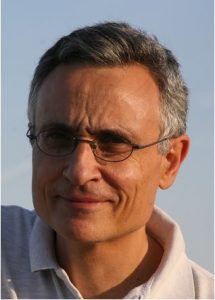
Can you say a few words about yourself?
I was born in Athens (Greece), a sunny region, with heavy history of several thousand years behind… During the ‘80s the city was suffering from severe air pollution episodes and this was something that was continuously triggering me to try to propose solutions. This led me to create – with other students – the first environmental group of young students in Greece to tackle this problem, among other urban problems that our city was facing at that time. A few years later, I received my 5-year Diploma in Electrical Engineering (with specialization in energy issues) from the National Technical University of Athens (NTUA). Still, the air pollution problem was not solved, thus, I had to act. A book I found at the NTUA’s library showed me the way: the (lidar technique) applications of lasers in air pollution detection and monitoring! A few weeks later, I did the 3-day train journey, from Athens to the University of Lund (Sweden) to meet Prof. Sune Svanberg, specialized in lidars, who introduced me to the lidar technique. And this was only the beginning… The same year I started my M.Sc. (DEA) Diploma in laser remote sensing at the University of Paris 7 (Paris Diderot, now called Paris Sorbonne) working as a research student on lidars at the Service d’Aéronomie du CNRS and the University Paris 6 (Pierre et Marie Curie, now called Paris Sorbonne). After this Diploma, I started my Ph.D. Thesis at the same University, where I, also, spent a couple of months as a post-doc researcher. During the Ph.D. years in Paris, I designed, manufactured, and tested the first prototype of a compact low cost O3 DIAL system for ground-based and airborne O3 profiling, under the guidance of the O3-pioneer Prof. Gérard Mégie (at that time President of the International Ozone Commission and later President of CNRS).
Did you choose your profession or did it choose you?
I really chose my profession as explained, shortly, in the previous paragraph; besides, working on solving environmental problems related to the atmosphere, is always a challenge for me.
What attracted you to join LAPI?
Working with Prof. Nenes, for more than 15 years, was always a way for me to discover new paths in atmospheric sciences. And this is, exactly, what attracted me to join LAPI, as it offered me the opportunity to pave new ways in biogenic aerosols, by exploring and identifying different types of atmospheric bio-aerosols aiming to gain further knowledge on their role in the cloud formation.
Can you speak about the projects you are currently working on and other ones in the past?
I have worked on a great number of national and international research progress aiming to develop lasers for medical and environmental applications, along with progressing the technology and scientific applications of the lidar technique in the retrieval of the optical, micro-physical and chemical properties of aerosols combining the lidar and meteorological data with mathematical inversion techniques and thermodynamic models. Starting from February 2021, I will spend several months at LAPI to further develop a novel lidar system for bio-aerosols profiling.
What have been some of your biggest successes?
I can mention three of them: i) the development of a compact, low cost and ground-based/airborne state-of-the-art lidar system for tropospheric ozone monitoring during my stay in CNRS,: ii) the design and running the European MEDCAPHOT Photochemical pollution Campaign in the Athens Basin to elucidate, for the first time, the mechanisms of photochemistry in the polluted and sunny area of Athens (Greece), and, iii) the development of a novel compact solid-state laser for aerosol profiling from space, funded by the European Space Agency, at NTUA with collaboration with Raymetrics SA.
You split your time between teaching and research. How do you view these two roles?
Splitting time between teaching and research is always very demanding, but very fruitful issue, as advanced research feeds teaching, and vice versa. Both roles must be fulfilled continuously and very successfully. However, teaching is a priority for me, as it is always gives me the pleasure to transmit always brand-new research results to my students. However, time is never enough for doing research, I would say!
What do you enjoy to do, outside of science and research?
Trekking in high mountains, swimming in the Mediterranean Sea, biking, listening baroque musique and (again) painting.
Where is the most interesting place you’ve been?
Brasil (outer parts of Amazonia), the Arctic circle and the top of the Helmos Mountain in the Peloponnese (Greece) during wintertime!
A free thought for the end?
Something I say to my students and friends: “Keep your eyes open all the times to catch the “chance” which may be in front of you, before it is lost forever, as time and life pass away very fast…”.